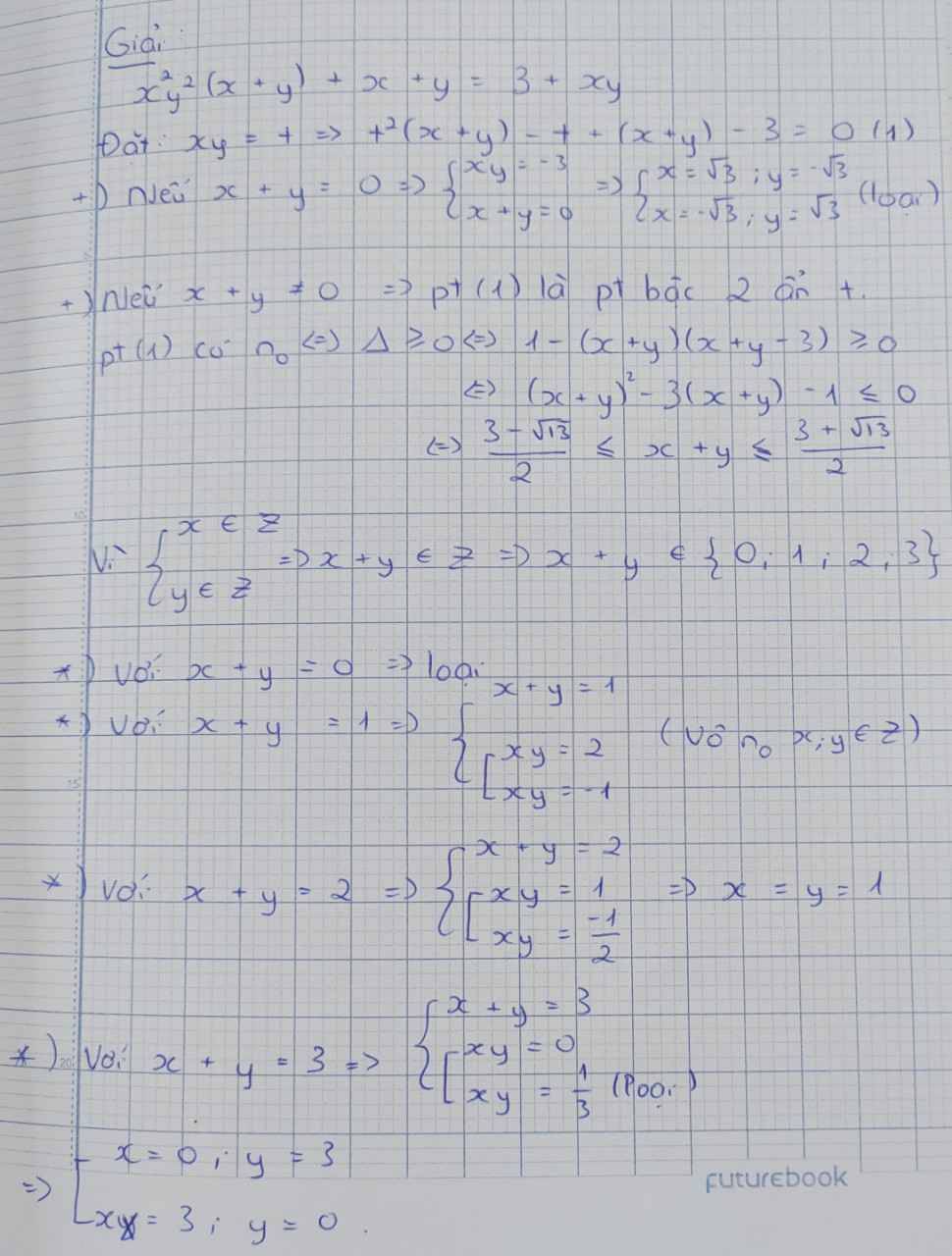Giải phương trình nghiệm nguyên: \(x+xy-x^2+y=1\)

Những câu hỏi liên quan
help me
1, giải phương tình nghiệm nguyên dương x^2y+x+y=xy^2z+yz+7z
2,giải phương trình nghiệm tự nhiên 2^x+3^y=z^2
3,giải phương trình nghiệm nguyên dương x^2+x+1=xyz-z
Giải phương trình nghiệm nguyên: \(x^2y-5x^2-xy-x+y-1=0\)
giải phương trình nghiệm nguyên x^2+xy-2x+1=x+y
Giải phương trình nghiệm nguyên \(x^3+x^2y+xy^2+y^3=8\left(x^2+xy+y^2+1\right)\)
Giải phương trình nghiệm nguyên: \(x^2+y^2=3-xy\)
\(x^2+y^2=3-xy\)
\(\Leftrightarrow\left(x-y\right)^2+2xy=3-xy\)
\(\Leftrightarrow\left(x-y\right)^2=3-3xy\)
\(\Leftrightarrow\left(x-y\right)^2=3\left(1-xy\right)\)
mà \(\left(x-y\right)^2\ge0,\forall x;y\inℤ\)
PT\(\Leftrightarrow\left\{{}\begin{matrix}x-y=3\\1-xy=3\end{matrix}\right.\) hay \(\left\{{}\begin{matrix}x-y=0\\1-xy=0\end{matrix}\right.\)
\(TH1:\left\{{}\begin{matrix}x-y=3\\1-xy=3\end{matrix}\right.\) \(\Leftrightarrow\left\{{}\begin{matrix}x=y+3\\xy=-2\end{matrix}\right.\)
\(\Leftrightarrow\left(x;y\right)\in\left\{\left(1;-2\right);\left(2;-1\right);\left(-1;2\right);\left(-2;1\right)\right\}\)
\(TH2:\left\{{}\begin{matrix}x-y=0\\1-xy=0\end{matrix}\right.\) \(\Leftrightarrow\left\{{}\begin{matrix}x=y\\xy=1\end{matrix}\right.\)
\(\Leftrightarrow\left(x;y\right)\in\left\{\left(1;1\right);\left(-1;-1\right)\right\}\)
Vậy \(\Leftrightarrow\left(x;y\right)\in\left\{\left(1;-2\right);\left(2;-1\right);\left(-1;2\right);\left(-2;1\right);\left(1;1\right);\left(-1;-1\right)\right\}\)
Đúng 1
Bình luận (0)
Giải phương trình nghiệm nguyên: \(x^2+y^2=3-xy\)
\(x^2+y^2=3-xy\)
\(\Leftrightarrow\left(x-y\right)^2=3.\left(1-xy\right)\)
\(\Leftrightarrow x-y=3\) và \(1-xy=3\)
\(\Leftrightarrow\left(x;y\right)=\left(1;-2\right),\left(2;-1\right),\left(-1;2\right),\left(-2;1\right)\)
hoặc \(x-y=0\) và \(1-xy=0\)
\(\Leftrightarrow\left(x;y\right)=\left(1;1\right),\left(-1;-1\right)\)
Đúng 0
Bình luận (0)
Giải phương trình nghiệm nguyên: x²y²(x+y)+x+y=3+xy
Giải phương trình nghiệm nguyên 2(x+y)+16-xy
2(x+y)+16-xy=0
<=> 2x+2y+16-xy=0
<=> y(2-x)-2(2-x)+20=0
<=> (2-x)(y-2)=-20
Vì x,y thuộc Z
=> 2-x;y-2 thuộc Z
=> 2-x;y-2 \(\inƯ\left(-20\right)=\left\{\pm1;\pm2;\pm4;\pm5;\pm10;\pm20\right\}\)
Xét bảng
| 2-x | 1 | -1 | 2 | -2 | 4 | -4 | 5 | -5 | 10 | -10 | 20 | -20 |
| y-2 | -20 | 20 | -10 | 10 | -5 | 5 | -4 | 4 | -2 | 2 | -1 | 1 |
| x | 1 | 3 | 0 | 4 | -2 | 6 | -3 | 7 | -8 | 12 | -18 | 22 |
| y | -18 | 22 | -8 | 12 | -3 | 7 | -2 | 6 | 0 | 4 | 1 | 3 |
Vậy.........
Giải phương trình nghiệm nguyên không âm: \(\left(1+x^2\right)\left(1+y^2\right)+4xy+2\left(x+y\right)\left(1+xy\right)=25\)
(1+x2)(1+y2)+4xy+2(x+y)(1+xy)=25(1+x2)(1+y2)+4xy+2(x+y)(1+xy)=25
↔x2+2xy+y2+x2y2+2xy.1+1+2(x+y)(1+xy)−25=0x2+2xy+y2+x2y2+2xy.1+1+2(x+y)(1+xy)−25=0
↔(x+y)2+2(x+y)(1+xy)+(1+xy)2−25=0(x+y)2+2(x+y)(1+xy)+(1+xy)2−25=0
↔(x+y+1+xy+5)(x+y+1+xy−5)=0(x+y+1+xy+5)(x+y+1+xy−5)=0→[x+y+xy=−6x+y+xy=4[x+y+xy=−6x+y+xy=4
Nếu x+y+xy=-6→(x+1)(y+1)=-5(vì x,yϵ z nên x+1,y+1ϵ z)
ta có bảng:
x+1 1 5 -1 -5
y+1 -5 -1 5 1
x 0 4 -2 -6
y -6 -2 4 0
→(x,y)ϵ{(0;−6),(4;−2)...}
Đúng 0
Bình luận (0)
\(\left(1+x^2\right)\left(1+y^2+4xy\right)+2\left(x+y\right)\left(1+xy\right)=25\)
\(\Leftrightarrow\) \(x^2+2xy+y^2+x^2y^2+2xy.1+1+2\left(x+y\right)\left(1+xy\right)-25=0\)
\(\Leftrightarrow\) \(\left(x+y\right)^2+2\left(x+y\right)\left(1+xy\right)+\left(1+xy\right)^2-25=0\)
\(\Leftrightarrow\) \(\left(x+y+1+xy+5\right)\left(x+y+1+xy-5\right)=0\) \(\Rightarrow\) \(\left\{{}\begin{matrix}x+y+xy=-6\\x+y+xy=4\end{matrix}\right.\)
nếu \(x+y+xy=-6\Rightarrow\left(x+1\right)\left(y+1\right)=-5\)
( vì \(x,y\in Z\) nên \(x+1;y+1\in Z\) )
ta lập bảng :
| \(x+1\) | \(1\) | \(5\) | \(-1\) | \(-5\) |
| \(y+1\) | \(-5\) | \(-1\) | \(5\) | \(1\) |
| \(x\) | \(0\) | \(4\) | \(-2\) | \(-6\) |
| \(y\) | \(-6\) | \(-2\) | \(4\) | \(0\) |
\(\Rightarrow\) \(x;y\in\left\{\left(0,6\right);\left(4,-2\right);\left(-2,4\right);\left(-6,0\right)\right\}\)
Đúng 1
Bình luận (0)






















